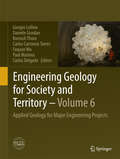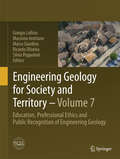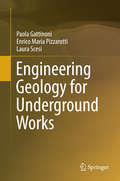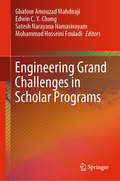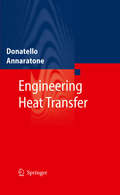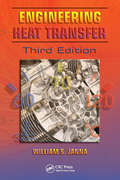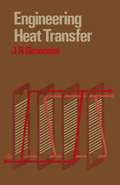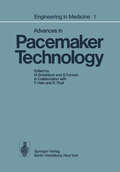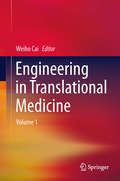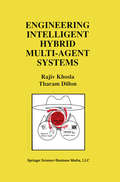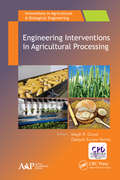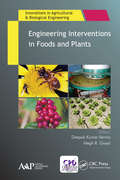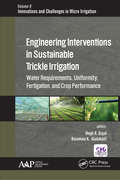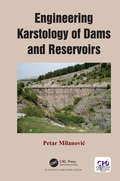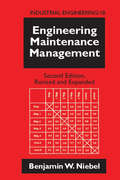- Table View
- List View
Engineering Geology for a Habitable Earth: Volume 4: Technological Innovation and Application for Engineering Geology (Environmental Science and Engineering)
by Rafig Azzam Runqiu Huang Vassilis P. Marinos Sijing WangThis book collects the selected papers of the XIV Congress of the International Association for Engineering Geology and the Environment held in Chengdu, Sichuan, China from September 21st - 27th, 2023, with the theme of Engineering Geology for a Habitable Earth. The meeting proceedings analyses the dynamic role of engineering geology in our changing world. The congress is expected to enhance the inter-disciplinary research development of international engineering geology and the environment, and contribute to the advancement of major projects, ecological progress, and habitable earth with in-depth discussion in the area of engineering geology and global climate change, geological hazard assessment and prevention, geotechnical properties of rock and soil mass, engineering geology and the environmental issues concerning marine, transportation, urban and ecological environment protection, engineering geology and resilience engineering construction, intelligent engineering geology, and new theories, methods, and techniques in engineering geology.
Engineering Geology for a Habitable Earth: Volume 2: Geohazard Mechanisms, Risk Assessment and Control, Monitoring and Early Warning (Environmental Science and Engineering)
by Rafig Azzam Runqiu Huang Vassilis P. Marinos Sijing WangThis book collects the selected papers of the XIV Congress of the International Association for Engineering Geology and the Environment held in Chengdu, Sichuan, China from September 21st - 27th, 2023, with the theme of Engineering Geology for a Habitable Earth. The meeting proceedings analyses the dynamic role of engineering geology in our changing world. The congress is expected to enhance the inter-disciplinary research development of international engineering geology and the environment, and contribute to the advancement of major projects, ecological progress, and habitable earth with in-depth discussion in the area of engineering geology and global climate change, geological hazard assessment and prevention, geotechnical properties of rock and soil mass, engineering geology and the environmental issues concerning marine, transportation, urban and ecological environment protection, engineering geology and resilience engineering construction, intelligent engineering geology, and new theories, methods, and techniques in engineering geology.
Engineering Geology for a Habitable Earth: Volume 1: Engineering Geomechanics of Rock and Soil Masses (Environmental Science and Engineering)
by Rafig Azzam Runqiu Huang Vassilis P. Marinos Sijing WangThis book collects the selected papers of the XIV Congress of the International Association for Engineering Geology and the Environment held in Chengdu, Sichuan, China from September 21st - 27th, 2023, with the theme of Engineering Geology for a Habitable Earth. The meeting proceedings analyses the dynamic role of engineering geology in our changing world. The congress is expected to enhance the inter-disciplinary research development of international engineering geology and the environment, and contribute to the advancement of major projects, ecological progress, and habitable earth with in-depth discussion in the area of engineering geology and global climate change, geological hazard assessment and prevention, geotechnical properties of rock and soil mass, engineering geology and the environmental issues concerning marine, transportation, urban and ecological environment protection, engineering geology and resilience engineering construction, intelligent engineering geology, and new theories, methods, and techniques in engineering geology.
Engineering Geology for a Habitable Earth: Volume 6: Marine and Deep Earth Engineering Geology (Environmental Science and Engineering)
by Rafig Azzam Runqiu Huang Vassilis P. Marinos Sijing WangThis book collects the selected papers of the XIV Congress of the International Association for Engineering Geology and the Environment held in Chengdu, Sichuan, China from September 21st - 27th, 2023, with the theme of Engineering Geology for a Habitable Earth. The meeting proceedings analyses the dynamic role of engineering geology in our changing world. The congress is expected to enhance the inter-disciplinary research development of international engineering geology and the environment, and contribute to the advancement of major projects, ecological progress, and habitable earth with in-depth discussion in the area of engineering geology and global climate change, geological hazard assessment and prevention, geotechnical properties of rock and soil mass, engineering geology and the environmental issues concerning marine, transportation, urban and ecological environment protection, engineering geology and resilience engineering construction, intelligent engineering geology, and new theories, methods, and techniques in engineering geology.
Engineering Geology for Society and Territory - Volume 6: Applied Geology for Major Engineering Projects
by Giorgio Lollino Daniele Giordan Kurosch Thuro Carlos Carranza-Torres Faquan Wu Paul Marinos Carlos DelgadoThis book is one out of 8 IAEG XII Congress volumes, and deals with the theme of applied geology, which is a critical theme for the global economy. In the international, multidisciplinary approach to major engineering projects (either to macro- or mega-scale), the application of geological investigation techniques is fundamental for properly selecting the location sites, planning the construction and maintaining the infrastructures. The contributions in this book include not only engineering constructions but also case studies related to large projects on geo-resources exploration and extraction (minerals, petroleum and groundwater), energy production (hydropower, geothermal, nuclear and others), transportation (railway and highway) and waste disposal as well as the environmental management of these and other activities. The Engineering Geology for Society and Territory volumes of the IAEG XII Congress held in Torino from September 15-19, 2014, analyze the dynamic role of engineering geology in our changing world and build on the four main themes of the congress: Environment, processes, issues, and approaches. The congress topics and subject areas of the 8 IAEG XII Congress volumes are: 1. Climate Change and Engineering Geology 2. Landslide Processes 3. River Basins, Reservoir Sedimentation and Water Resources 4. Marine and Coastal Processes 5. Urban Geology, Sustainable Planning and Landscape Exploitation 6. Applied Geology for Major Engineering Projects 7. Education, Professional Ethics and Public Recognition of Engineering Geology 8. Preservation of Cultural Heritage.
Engineering Geology for Society and Territory - Volume 7: Education, Professional Ethics and Public Recognition of Engineering Geology
by Giorgio Lollino Massimo Arattano Marco Giardino Ricardo Oliveira Silvia PeppoloniThis book is one out of 8 IAEG XII Congress volumes and deals with education and the professional ethics, which scientists, regulators and practitioners of engineering geology inevitably have to face through the purposes, methods, limitations and findings of their works. This volume presents contributions on the professional responsibilities of engineering geologists; the interaction of engineering geologists with other professionals; recognition of the engineering geological profession and its particular contribution to society, culture, and economy and implications for the education of engineering geologists at tertiary level and in further education schemes. Issues treated in this volume are: the position of engineering geology within the geo-engineering profession; professional ethics and communication; resource use and re-use; managing risk in a litigious world; engineering and geological responsibility and engineering geology at tertiary level. The Engineering Geology for Society and Territory volumes of the IAEG XII Congress held in Torino from September 15-19, 2014, analyze the dynamic role of engineering geology in our changing world and build on the four main themes of the congress: Environment, processes, issues and approaches. The congress topics and subject areas of the 8 IAEG XII Congress volumes are: Climate Change and Engineering Geology. Landslide Processes. River Basins, Reservoir Sedimentation and Water Resources. Marine and Coastal Processes. Urban Geology, Sustainable Planning and Landscape Exploitation. Applied Geology for Major Engineering Projects. Education, Professional Ethics and Public Recognition of Engineering Geology. Preservation of Cultural Heritage.
Engineering Geology for Underground Works
by Paola Gattinoni Enrico Maria Pizzarotti Laura ScesiThe construction of tunnels involves the resolution of various complex technical problems depending on the geological and geological-environmental context in which the work fits.Only a careful analysis of all the geological and geological-environmental issues and a correct reconstruction of the conceptual model can lead to optimal design solutions from all points of view (including financial) and ensure the safety of workers during the construction and users in the operation phase.It was therefore felt that there was a need to collect in one volume the state of current knowledge about:all the geological and environmental issues related to the construction of underground works the different methodologies used for the reconstruction of the conceptual model the different risk typologies that it is possible to encounter or that can arise from tunnel construction, and the most important risk assessment, management and mitigation methodologies that are used in tunneling studies.
Engineering Grand Challenges in Scholar Programs
by Ghafour Amouzad Mahdiraji Edwin C.Y. Chung Satesh Narayana Namasivayam Mohammad Hosseini FouladiThis book explains how Taylor’s University implemented a curriculum in their engineering program that prepares students to address challenges facing the world. Aim is to enable Engineers put their knowledge into application to meet the 14 challenges of the century as outlined by the National Academy of Engineering (NAE) of the United States. The research groups are organized around the 14 grand challenges for engineering The structure of their syllabi is organized in a way that they address the 5 core competencies: Research Experience, Entrepreneurship, Service Learning, Interdisciplinary Curriculum, Global Dimension. It uses the CDIO educational framework, a project-based learning approach that provides students with the big picture of engineering. Through this method, students are able to: Master a deeper working knowledge of the fundamentals of engineering Lead in the creation and operation of new products and systems Understand the importance and strategic value of research work As the only programe of its kind outside North America, it offers the brightest minds the opportunity to face real-world issues and places them on the cutting edge of the engineering world.
Engineering Heat Transfer
by Donatello AnnaratoneThis book is a generalist textbook; it is designed for anybody interested in heat transmission, including scholars, designers and students. Two criteria constitute the foundation of Annaratone’s books, including the present one. The first one consists of indispensable scientific rigor without theoretical exasperation. The inclusion in the book of some theoretical studies, even if admirable for their scientific rigor, would have strengthened the scientific foundation of this publication, yet without providing the reader with further applicable know-how. The second criterion is to deliver practical solution to operational problems. This criterion is fulfilled through equations based on scientific rigor, as well as a series of approximated equations, leading to convenient and practically acceptable solutions, and through diagrams and tables. When a practical case is close to a well defined theoretical solution, corrective factors are shown to offer simple and correct solutions to the problem.
Engineering Heat Transfer (Heat Transfer)
by William S. JannaMost heat transfer texts include the same material: conduction, convection, and radiation. How the material is presented, how well the author writes the explanatory and descriptive material, and the number and quality of practice problems is what makes the difference. Even more important, however, is how students receive the text. Engineering Heat Transfer, Third Edition provides a solid foundation in the principles of heat transfer, while strongly emphasizing practical applications and keeping mathematics to a minimum. New in the Third Edition: Coverage of the emerging areas of microscale, nanoscale, and biomedical heat transfer Simplification of derivations of Navier Stokes in fluid mechanics Moved boundary flow layer problems to the flow past immersed bodies chapter Revised and additional problems, revised and new examples PDF files of the Solutions Manual available on a chapter-by-chapter basis The text covers practical applications in a way that de-emphasizes mathematical techniques, but preserves physical interpretation of heat transfer fundamentals and modeling of heat transfer phenomena. For example, in the analysis of fins, actual finned cylinders were cut apart, fin dimensions were measures, and presented for analysis in example problems and in practice problems. The chapter introducing convection heat transfer describes and presents the traditional coffee pot problem practice problems. The chapter on convection heat transfer in a closed conduit gives equations to model the flow inside an internally finned duct. The end-of-chapter problems proceed from short and simple confidence builders to difficult and lengthy problems that exercise hard core problems solving ability. Now in its third edition, this text continues to fulfill the author’s original goal: to write a readable, user-friendly text that provides practical examples without overwhelming the student. Using drawings, sketches, and graphs, this textbook does just that.PDF files of the Solutions Manual are available upon qualifying course adoptions.
Engineering Heat Transfer (Heat Transfer)
by William S. JannaMost heat transfer texts include the same material: conduction, convection, and radiation. How the material is presented, how well the author writes the explanatory and descriptive material, and the number and quality of practice problems is what makes the difference. Even more important, however, is how students receive the text. Engineering Heat Transfer, Third Edition provides a solid foundation in the principles of heat transfer, while strongly emphasizing practical applications and keeping mathematics to a minimum. New in the Third Edition: Coverage of the emerging areas of microscale, nanoscale, and biomedical heat transfer Simplification of derivations of Navier Stokes in fluid mechanics Moved boundary flow layer problems to the flow past immersed bodies chapter Revised and additional problems, revised and new examples PDF files of the Solutions Manual available on a chapter-by-chapter basis The text covers practical applications in a way that de-emphasizes mathematical techniques, but preserves physical interpretation of heat transfer fundamentals and modeling of heat transfer phenomena. For example, in the analysis of fins, actual finned cylinders were cut apart, fin dimensions were measures, and presented for analysis in example problems and in practice problems. The chapter introducing convection heat transfer describes and presents the traditional coffee pot problem practice problems. The chapter on convection heat transfer in a closed conduit gives equations to model the flow inside an internally finned duct. The end-of-chapter problems proceed from short and simple confidence builders to difficult and lengthy problems that exercise hard core problems solving ability. Now in its third edition, this text continues to fulfill the author’s original goal: to write a readable, user-friendly text that provides practical examples without overwhelming the student. Using drawings, sketches, and graphs, this textbook does just that.PDF files of the Solutions Manual are available upon qualifying course adoptions.
Engineering in Medicine: Volume 1: Advances in Pacemaker Technology
by F. Hein R. ThullAfter more than a decade of successful application of cardiac pace makers in the therapy of cardiac rhythm disorders, technological and clinical experience has reached a level, at which a technical survey of this field should be of general interest and might promote the further improvement of pace maker therapy. The papers contained in this book were presented at the International Symposium on Advances in Pacemaker Technology, held at Erlangen on Sep tember 26 and 27,1974 under the auspices of the Societas Physica Medica Erlangensis. One of the traditional aims of the Societas has been the advance ment of diagnosis and therapy by the adaptation of medical skill to modern technology and scientific engineering conceptions. The major objective of this book is to present, in expanded form, the lectures given by internationally known basic and clinical researchers in the field of artificial pacing of the heart and to make that information available to a wider public. The experience discussed covers the principles and main methods of pacing using implantable and external, fixed rate, R-wave or P-wave triggered pacemakers with electrodes placed in the myocardium either surgically or transvenously, and powered by zinc-mercury oxide or rechargeable batteries. Particular emphasis was put on problems of pressing importance at the present time, such as the increase of pacemaker longevity with lithium iodide and nuclear-powered batteries or improved electrodes, as well as the postoperative management of a steadily increasing number of pacemaker patients.
Engineering in Translational Medicine
by Weibo CaiThis book covers a broad area of engineering research in translational medicine. Leaders in academic institutions around the world contributed focused chapters on a broad array of topics such as: cell and tissue engineering (6 chapters), genetic and protein engineering (10 chapters), nanoengineering (10 chapters), biomedical instrumentation (4 chapters), and theranostics and other novel approaches (4 chapters). Each chapter is a stand-alone review that summarizes the state-of-the-art of the specific research area.Engineering in Translational Medicine gives readers a comprehensive and in-depth overview of a broad array of related research areas, making this an excellent reference book for scientists and students both new to engineering/translational medicine and currently working in this area. The ability for engineering approaches to change biomedical research are increasing and having significant impact. Development of basic assays and their numerous applications are allowing for many new discoveries and should eventually impact human health. This book brings together many diverse yet related topics to give the reader a solid overview of many important areas that are not found together elsewhere. Dr. Weibo Cai has taken great care to select key research leaders of many sub-disciplines who have put together very detailed chapters that are easy to read yet highly rich in content. _______________This book brings together many diverse yet related topics to give the reader a solid overview of many important areas that are not found together elsewhere. Dr. Weibo Cai has taken great care to select key research leaders of many sub-disciplines who have put together very detailed chapters that are easy to read yet highly rich in content. It is very exciting to see such a great set of chapters all together to allow one to have a key understanding of many different areas including cell, gene, protein, and nano engineering as well as the emerging field of theranostics. I am sure the readers will find this collection of important chapters helpful in their own research and understanding of how engineering has and will continue to play a critical role in biomedical research and clinical translation. Sanjiv Sam Gambhir M.D., Ph.D.Stanford University, USA Engineering in Translational Medicine is a landmark book bridging the fields of engineering and medicine with a focus on translational technologies and methods. In a single, well-coordinated volume, this book brings together contributions from a strong and international scientific cast, broadly covering the topics. The book captures the tremendous opportunities made possible by recent developments in bioengineering, and highlights the potential impact of these advances across a broad spectrum of pressing health care needs. The book can equally serve as a text for graduate level courses, a reference source, a book to be dipped into for pleasure by those working within the field, or a cover-to-cover read for those wanting a comprehensive, yet readable introduction to the current state of engineering advances and how they are impacting translational medicine. Simon R. Cherry, Ph.D.University of California, Davis, USA
Engineering Intelligent Hybrid Multi-Agent Systems
by Rajiv KhoslaEngineering Intelligent Hybrid Multi-Agent Systems is about building intelligent hybrid systems. Included is coverage of applications and design concepts related to fusion systems, transformation systems and combination systems. These applications are in areas involving hybrid configurations of knowledge-based systems, case-based reasoning, fuzzy systems, artificial neural networks, genetic algorithms, and in knowledge discovery and data mining. Through examples and applications a synergy of these subjects is demonstrated. The authors introduce a multi-agent architectural theory for engineering intelligent associative hybrid systems. The architectural theory is described at both the task structure level and the computational level. This problem-solving architecture is relevant for developing knowledge agents and information agents. An enterprise-wide system modeling framework is outlined to facilitate forward and backward integration of systems developed in the knowledge, information, and data engineering layers of an organization. In the modeling process, software engineering aspects like agent oriented analysis, design and reuse are developed and described. Engineering Intelligent Hybrid Multi-Agent Systems is the first book in the field to provide details of a multi-agent architecture for building intelligent hybrid systems.
Engineering Interventions in Agricultural Processing: Innovative Approaches In Processing, Preservation, And Analysis Of Milk Products (Innovations in Agricultural & Biological Engineering)
by Megh R. Goyal Deepak Kumar VermaEngineering Interventions in Agricultural Processing presents recent advanced research on biological engineering, bioprocessing technologies, and their applications in agricultural food processing, and their applications in agriculture science and agricultural engineering, focusing on biological science, biological engineering, and bioprocessing technology. With contributions from a broad range of leading researchers, this book presents several innovations in the areas of processing technologies in agriculture. The book is divided into three parts, covering agricultural processing: interventions in engineering technologies novel practices in agricultural processing agricultural processing: health benefits of medicinal plants With contributions from a broad range of leading researchers, this book presents several new innovations in the areas of processing technologies in agriculture that will be helpful to researchers, scientists, students, and industry professionals in agriculture.
Engineering Interventions in Agricultural Processing (Innovations in Agricultural & Biological Engineering)
by Megh R. Goyal Deepak Kumar VermaEngineering Interventions in Agricultural Processing presents recent advanced research on biological engineering, bioprocessing technologies, and their applications in agricultural food processing, and their applications in agriculture science and agricultural engineering, focusing on biological science, biological engineering, and bioprocessing technology. With contributions from a broad range of leading researchers, this book presents several innovations in the areas of processing technologies in agriculture. The book is divided into three parts, covering agricultural processing: interventions in engineering technologies novel practices in agricultural processing agricultural processing: health benefits of medicinal plants With contributions from a broad range of leading researchers, this book presents several new innovations in the areas of processing technologies in agriculture that will be helpful to researchers, scientists, students, and industry professionals in agriculture.
Engineering Interventions in Foods and Plants (Innovations in Agricultural & Biological Engineering)
by Deepak Kumar Verma Megh R. GoyalWith contributions from a broad range of leading professors and scientists, this volume focuses on new areas of processing technologies in foods and plants to help meet the increasing food demand of the rapidly growing populations of the world. The first section of the book is devoted to emerging entrepreneurship and employment opportunities for rural peoples in food and agricultural processing, specifically beekeeping technology and honey processing; herbal formulations for treatment of dental diseases; and engineering interventions for the extraction of essential oils from plants. Part 2 contains three chapters that discuss technological interventions in foods and plants for human health benefits, looking particularly at coffee, tea, and green leaf vegetable processing technology. The volume goes to look at several management strategies in agricultural engineering, with a chapter on production technology of ethanol from various sources and its potential applications in various industries, including chemical, food, pharmaceutical as well as biofuel. Food grain storage structures are addressed as well, focusing on minimizing losses from microbial pests as well as insect pests during grain storage by utilizing different efficient storage structures The volume provides a valuable resource for students, instructors, and researchers of foods and plants processing technology. In addition, food and plant science professionals who are seeking recent advanced and innovative knowledge in processing will find this book helpful.
Engineering Interventions in Foods and Plants (Innovations in Agricultural & Biological Engineering)
by Deepak Kumar Verma Megh R. GoyalWith contributions from a broad range of leading professors and scientists, this volume focuses on new areas of processing technologies in foods and plants to help meet the increasing food demand of the rapidly growing populations of the world. The first section of the book is devoted to emerging entrepreneurship and employment opportunities for rural peoples in food and agricultural processing, specifically beekeeping technology and honey processing; herbal formulations for treatment of dental diseases; and engineering interventions for the extraction of essential oils from plants. Part 2 contains three chapters that discuss technological interventions in foods and plants for human health benefits, looking particularly at coffee, tea, and green leaf vegetable processing technology. The volume goes to look at several management strategies in agricultural engineering, with a chapter on production technology of ethanol from various sources and its potential applications in various industries, including chemical, food, pharmaceutical as well as biofuel. Food grain storage structures are addressed as well, focusing on minimizing losses from microbial pests as well as insect pests during grain storage by utilizing different efficient storage structures The volume provides a valuable resource for students, instructors, and researchers of foods and plants processing technology. In addition, food and plant science professionals who are seeking recent advanced and innovative knowledge in processing will find this book helpful.
Engineering Interventions in Sustainable Trickle Irrigation: Irrigation Requirements and Uniformity, Fertigation, and Crop Performance (Innovations in Agricultural & Biological Engineering)
by Megh R. Goyal Basamma K. AladakattiImproving agricultural water use efficiency (WUE) is vitally important in many parts of the world due to the decreasing availability of water resources and the increasing competition for water between different users. Micro irrigation is an effective tool for conserving water resources. Studies have revealed a significant water savings, ranging from 40% to 70% under drip irrigation compared with surface irrigation. This new volume, Engineering Interventions in Sustainable Trickle Irrigation: Irrigation Requirements and Uniformity, Fertigation, and Crop Performance, presents valuable research that evaluates crop water and fertigation requirements, examines optimum irrigation and fertigation scheduling, and analyzes the performance of agricultural crops under micro irrigation. With an interdisciplinary perspective, this volume addresses the urgent need to explore and investigates the current shortcomings and challenges of water resources engineering, especially in micro irrigation engineering. The volume discusses crop water requirements, fertigation technology, and performance of agricultural crops under best management practices. The chapter authors present research studies on drip irrigated tomato, chilies, cucumber, eggplant, cabbage, garlic, sugarcane maize, cashew nut, sapota, banana, mango, and blueberries. Removing the research gap, this volume provides new information that will be valuable to those involved in micro irrigation engineering.
Engineering Interventions in Sustainable Trickle Irrigation: Irrigation Requirements and Uniformity, Fertigation, and Crop Performance (Innovations in Agricultural & Biological Engineering)
by Megh R. Goyal Basamma K. Aladakatti Pradeep KumarImproving agricultural water use efficiency (WUE) is vitally important in many parts of the world due to the decreasing availability of water resources and the increasing competition for water between different users. Micro irrigation is an effective tool for conserving water resources. Studies have revealed a significant water savings, ranging from 40% to 70% under drip irrigation compared with surface irrigation. This new volume, Engineering Interventions in Sustainable Trickle Irrigation: Irrigation Requirements and Uniformity, Fertigation, and Crop Performance, presents valuable research that evaluates crop water and fertigation requirements, examines optimum irrigation and fertigation scheduling, and analyzes the performance of agricultural crops under micro irrigation. With an interdisciplinary perspective, this volume addresses the urgent need to explore and investigates the current shortcomings and challenges of water resources engineering, especially in micro irrigation engineering. The volume discusses crop water requirements, fertigation technology, and performance of agricultural crops under best management practices. The chapter authors present research studies on drip irrigated tomato, chilies, cucumber, eggplant, cabbage, garlic, sugarcane maize, cashew nut, sapota, banana, mango, and blueberries. Removing the research gap, this volume provides new information that will be valuable to those involved in micro irrigation engineering.
Engineering Karstology of Dams and Reservoirs
by Petar MilanovićKarst terrains have been modified and adapted through a range of human activities as the need for flood control, irrigation, food production, hydropower production and other resources has increased. Successful reclamation projects require construction of dams and reservoirs. Karst terrains present the most complex working conditions for dam foundation and realization of safe reservoir space. Practical engineering solutions are extremely complex and the need for successful solution requires serious investigations and the cooperation of a wide spectrum of scientists and engineers. A wealth of data on dam projects in karst has been collected and presented in this book. Since reservoirs in karst may fail to fill despite extensive investigations and remediation treatment the book includes a description of failures as well.
Engineering Karstology of Dams and Reservoirs
by Petar MilanovićKarst terrains have been modified and adapted through a range of human activities as the need for flood control, irrigation, food production, hydropower production and other resources has increased. Successful reclamation projects require construction of dams and reservoirs. Karst terrains present the most complex working conditions for dam foundation and realization of safe reservoir space. Practical engineering solutions are extremely complex and the need for successful solution requires serious investigations and the cooperation of a wide spectrum of scientists and engineers. A wealth of data on dam projects in karst has been collected and presented in this book. Since reservoirs in karst may fail to fill despite extensive investigations and remediation treatment the book includes a description of failures as well.
Engineering Maintenance Management
by Benjamin W. NiebelThis work sets out to furnish all levels of engineering management with the material necessary to provide cost-effective maintenance, discussing the functional design of products as well as the identification of failure systems that permit scheduled maintenance procedures. This second edition presents information on ISO 9000 requirements, utilities
Engineering Materials: Research, Applications and Advances
by K.M. GuptaIntroduces Emerging Engineering MaterialsMechanical, materials, and production engineering students can greatly benefit from Engineering Materials: Research, Applications and Advances. This text focuses heavily on research, and fills a need for current information on the science, processes, and applications in the field. Beginning with a bri




